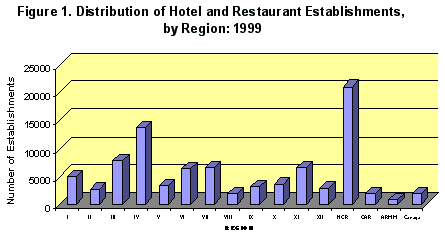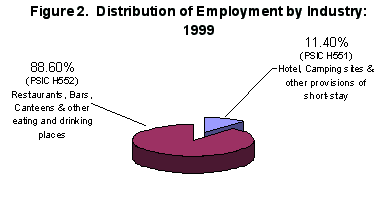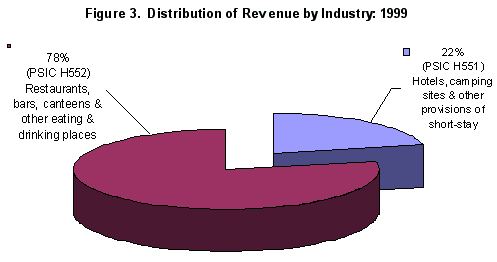Restaurants, bars, canteens and other eating and drinking places accounted for majority of establishments
-
A total of 88,171 hotels, restaurants and similar establishments nationwide were reported in the 2000 Census of Philippine Business and Industry (CPBI) of which 85,333 or 96.78 percent had an average total employment (ATE) of less than 20. The remaining 2,838 or 3.22 percent had ATE 20 and over, See Table 1 for the summary statistics of all hotel and restaurant establishments.
-
Majority of these establishments, 95.88 percent were restaurants, bars, canteens and other eating and drinking places (PSIC H551) while hotels, camping sites and other provisions of short stay accommodation, (PSIC H552) made up 4.12 percent of the total count.
-
Establishments were concentrated in the National Capital Region (NCR) where 21,017 or 23.84 percent were located. The Autonomous Region in Muslim Mindanao (ARMM) accounted for the least number with 767. Figure 1 shows the distribution of hotels and restaurants by region.

Employment is also bigger in restaurants, bars, canteens and other eating and drinking places
-
The sector provided employment to same 492,762 workers 71.18 percent of which were paid employees. Most of these employees, 88.60 percent were hired by restaurants and other eating and drinking places while 11.40 percent worked in hotels and similar establishments. Figure 2 displays the distribution of employment by industry major group.

-
Regional distribution shows the NCR employed some 169,113 or 34.32 percent of total workforce. Southern Tagalog had the second biggest employment with 66,828 while ARMM managed to employ only 3,322, the lowest among the regions.
But average monthly compensation per employee is higher in hotels and similar establishments
-
Compensation paid amounted to almost P 19 billion in 1999. This translates to an average monthly compensation per paid employee of P 4,514.
-
On the average, employees of hotels and similar establishments were better paid, P 8,661 per month than those employed by restaurants and other eating and drinking places who received P 3,808.
National Capital Region earns the largest revenue but also incurs the biggest expenditure
-
Total revenue earned by the sector amounted to P113.65 billion. Hotels and similar establishments contribution was only P24.66 billion or 21.7 percent of the total while restaurants and similar establishments contributed a bigger share of P88.99 billion or 78.3 percent. Figure 3 illustrates distribution of revenue by industry group.

-
Excluding compensation paid to employees, total cost spent to operate and maintain hotels, restaurants and similar establishments reached P 71 billion.
-
Bulk of total revenue and cost were generated and incurred by NCR, 58.13 percent and 57.68 percent respectively.
-
Revenue per worker, a measure of labor productivity was estimated at P 0.231 million. Hotels and similar establishments exhibited a higher labor productivity at P 0.439 million. On the other hand, restaurants and other eating and drinking places had a lower productivity at P 0.204 million. Figure 4 shows same economic indicators for the sector. See also Table R1 to R3 for other economic indicators.

TECHNICAL NOTES
Scope and Coverage:
The 2000 Census of Philippine Business and Industry (CPBI) formerly known as Census of Establishments (CE) was conducted to collect benchmark information on economic activities in the entire country for the year 1999. Covered were establishments engaged in economic activities as defined under the 1994 Philippine Standard Industrial Classification (PSIC). These establishments were classified into 14 sectors, one of which is on hotels and restaurants (Sector H). The sector is composed of hotels, camping sites and other provisions of short-stay accommodations (H551) and restaurants, bars canteens and other eating and drinking places (H552).
All hotel and restaurant establishments nationwide with average total employment (ATE) of 20 and over were covered on a 100 percent basis and those with ATE of less than 20 were selected using probability proportional to size sampling.
Response Rate
A total of 3,717 or 72.84 percent responded out of the 5,103 samples drawn for the sector. Adjustments for non-response were made through imputations.
Concepts and Definition of Terms
Establishment - an economic unit which engaged under a single ownership or control, that is, one or predominantly one kind of economic activity at a single fixed physical location.
Average total employment (ATE) - the sum of the number of persons who worked in or for the establishment for all months of the year divided by 12 regardless of the number of months the establishment was in operation.
Paid employees - all persons working in the establishments receiving pay as well as those working away from the establishment when paid by and under the control of the establishments.
Unpaid workers - persons working without regular pay for at least one-third of the working time normal to the establishment.
Salaries and wages - payments whether in cast or in kind, prior to deduction for employees contribution to SSS/GSIS, withholding tax, and the like, to all employees. Included are total basic pay, overtime pay, and benefits.
Revenue - includes cash received and receivable for goods sold and services rendered.
Cost - all expenses incurred during the year whether paid or payable. Excluded are depreciation, donations and contributions, bad debts, income tax, salaries and wages and loss.
Gross additions to fixed assets - the sum of cost of new and used fixed assets acquired during the year, cost of alteration and improvements done by others and cost of fixed assets produced by the establishment less the value of sales of fixed assets during the year.
Change in inventories - the value of ending inventory less the value of beginning inventory.
Subsidies - special grants in the form of financial assistance or tax exemption or tax privilege given by the government to develop an industry or production and to protect it against competition.
Source: National Statistics Office
Manila, Philippines
